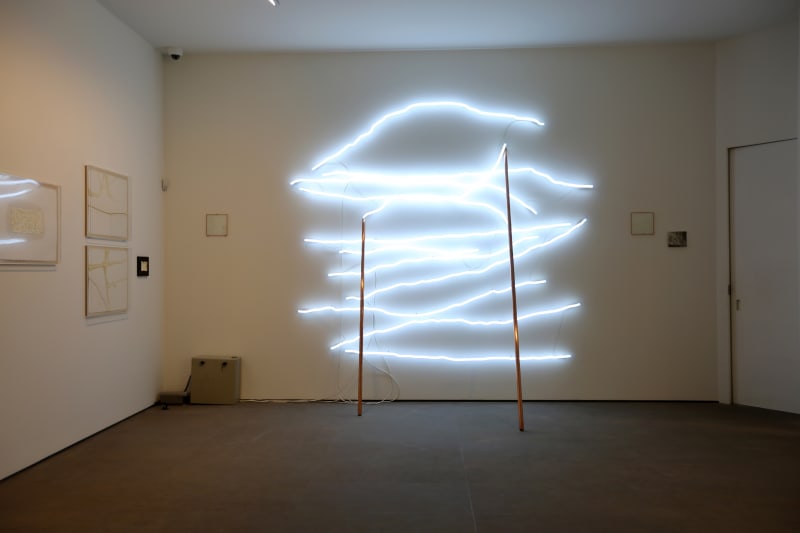The Galerie Nathalie Obadia is very pleased to present Au commencement le blanc by Sarkis, its third collaboration with the artist following Opus 2 in 2011 and Aura d’après Vaudou in 2012.
Au commencement le blanc brings together a large selection of works on the theme of white, which have either never been shown or are from an earlier period. In a precise and accurate manner, Sarkis has treated the gallery as though he were a musical composer. By arranging his works like sounds, whose formal intonation he has fine-tuned through their positioning and the participation of the observer, Sarkis has created a score of great expression.
The tone of the exhibition and the welcome offered to the visitor is given by the aphonic cry of Sarkis’s reinterpretation of Edvard Munch’s Scream. The four accomplished wall sculptures in neon and copper define the four primary sound tempos with the intensity of their light: D’après Satantango de Béla Tarr (2013), Scène en cuivre avec néons (2012), La colonne vertébrale du Retable d’Isenheim de Grünewald (2012) and À la limite de 120 cm (2012).
As an accompaniment to this arrangement, the artist has thrown in a few harmonies at random intervals: his Ikones offer a cadenced rhythm to possible interpretations, two works on the floor – After Ice Age (2013) and L’Attente (1969) – provide a counterpoint to the mural works, a previously unseen series of drawings with the title Uruchi is inspired by Kintsugi, the Japanese technique of ceramic repair, the experience of which he prolongs using torn paper, white fingerprints on coloured glass reveal the delicate touch of the artist and his glazier master, and the video Blanc sur noir jour et nuit (2007) makes light of the physical properties of watercolour in a bowl of water, while Sarkis reflects on the creative possibilities offered by the medium.
For After Ice Age (2013), Sarkis has arranged fifty oils on paper in a metal cabinet rather like a filing case for prints. As in the series Aura d’après Vaudou, in which he allowed the oil of the paint to act freely outside the motif bounded by the brush, here he has taken inspiration from prehistoric objects that were exhibited in Ice Age Art, Arrival of the Modern Mind at the British Museum in 2012. In D’Après Satantango de Béla Tarr, some of his Ikones, and a selection of works on paper – R1, R2, R3, R8, R10 and R11, in which he has carefully worked the titanium white or zinc white in the same way he would plough earth in furrows as preparation before planting – he husked grains of rice, a completely new material in his work, onto the pure matter.
By inviting observers to touch the coloured glass, to consult the drawings in the metal cabinet and to manipulate curtains made from ancient silk, Sarkis offers us the tactile and bodily sensations involved in the interaction with his works. With his restriction on unproductive gestures and a rigorous choice of strongly evocative materials – neon, gold, oil, brick, paper, silk, copper and feather – Sarkis offers a remarkable orchestration of discernment and plastic intelligence. And it is in a similarly constrained manner that Au commencement le blanc proposes a contemporary digression to the visitor, without Sarkis’s works ever losing control of their power.

